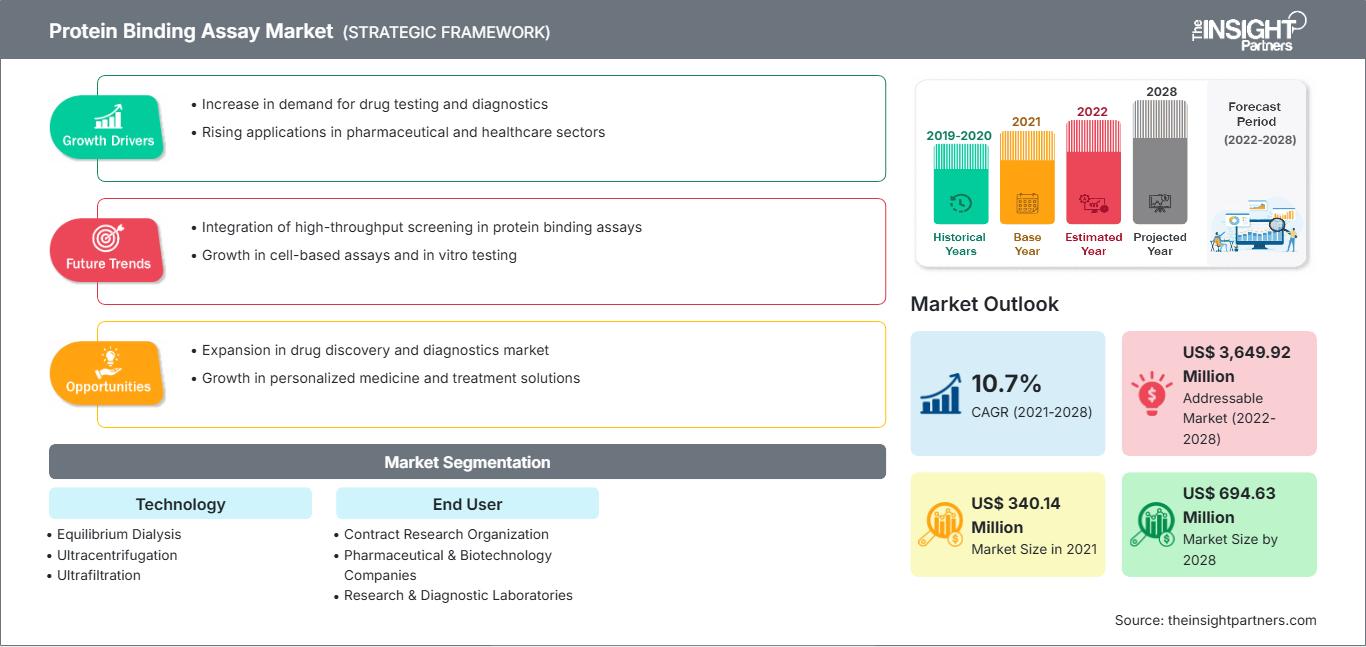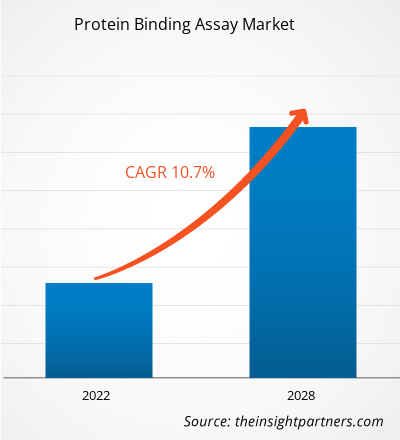Der Markt für Proteinbindungstests soll von 340,14 Millionen US-Dollar im Jahr 2021 auf 694,63 Millionen US-Dollar im Jahr 2028 anwachsen; das Wachstum wird von 2021 bis 2028 auf durchschnittlich 10,7 % geschätzt.
Proteinbindungstests unterstützen die Analyse der Interaktion zwischen zwei Proteinarten. Diese Tests werden häufig in der Arzneimittelentwicklung eingesetzt.
Der Markt für Proteinbindungstests ist nach Technologie, Endnutzer und Geografie segmentiert. Geografisch unterteilt sich der Markt grob in Nordamerika, Europa, Asien-Pazifik, den Nahen Osten und Afrika sowie Süd- und Mittelamerika. Der Bericht bietet Einblicke und eine detaillierte Analyse des Marktes, wobei Parameter wie Markttrends, technologischer Fortschritt und Marktdynamik im Mittelpunkt stehen. Darüber hinaus analysiert er die Wettbewerbslandschaft der weltweit führenden Marktteilnehmer.
Markteinblicke
Passen Sie diesen Bericht Ihren Anforderungen an
Sie erhalten kostenlos Anpassungen an jedem Bericht, einschließlich Teilen dieses Berichts oder einer Analyse auf Länderebene, eines Excel-Datenpakets sowie tolle Angebote und Rabatte für Start-ups und Universitäten.
Markt für Proteinbindungstests: Strategische Einblicke

-
Holen Sie sich die wichtigsten Markttrends aus diesem Bericht.Dieses KOSTENLOSE Beispiel umfasst Datenanalysen, die von Markttrends bis hin zu Schätzungen und Prognosen reichen.
Eine klinische Studie ist ein entscheidender und wichtiger Schritt zur Bestimmung der Sicherheit und Wirksamkeit einer medizinischen Strategie, Behandlung und eines Geräts für die kommerzielle Nutzung. Diese Studien helfen auch, die besten medizinischen Ansätze für ein bestimmtes Therapiegebiet zu verstehen und zu bestimmen. Vor der Zulassung von Arzneimittelmolekülen oder Medizinprodukten durch die Aufsichtsbehörden werden eine Reihe klinischer Studien durchgeführt. Die zunehmende Verbreitung übertragbarer und nicht übertragbarer Krankheiten löst die Nachfrage nach der Entwicklung neuer Medikamente und Medizinprodukte aus, was wiederum die Nachfrage nach Proteinbindungstests antreibt. Laut Daten der US National Library of Medicine liefen im Jahr 2018 rund 280.801 klinische Studien in 50 Bundesstaaten und 204 Ländern. Die folgende Abbildung zeigt den Anstieg der Anzahl der im Zeitraum von 2015 bis 2020 registrierten Studien.
-
Anzahl der registrierten Studien für klinische Prüfungen
|
Jahr der ersten Veröffentlichung |
Studien zu Beginn des Jahres |
Studien während des Jahres |
Studien am Ende des Jahr |
|
2015 |
181.304 |
24.130 |
205.434 |
|
2016 |
205.434 </ td> |
27.809 |
233.243 |
|
2017 |
233.243 |
29.198 |
262.441 |
| < p>2018 |
262.441 |
17.836 |
280.277 |
|
2019 |
293.275 |
32.519 |
325.794 |
|
2020 |
325.794 |
36.740 |
362.534 |
Darüber hinaus Pharmaunternehmen, Medizintechnikunternehmen und Biotechnologieunternehmen konzentrieren sich auf Forschungs- und Entwicklungsaktivitäten (F&E), um neue Moleküle für therapeutische Anwendungen mit dem größten medizinischen und kommerziellen Potenzial zu entwickeln. Die Unternehmen investieren hauptsächlich in F&E, um qualitativ hochwertige und innovative Produkte auf den Markt zu bringen.
-
Top 10 der Pharmaunternehmen mit den höchsten F&E-Ausgaben, 2019
|
Name des Unternehmens (F&E-Budget als % des Umsatzes) |
Name des Unternehmens (F&E-Budget als % des Umsatzes) |
|
1. F. Hoffmann La-Roche Ltd. (19,0 %) |
2. Johnson & Johnson Services, Inc. (13,8 %) |
|
3. Merck KGaA (21,1 %) |
4. Novartis AG (19,8 %) |
|
5. Pfizer, Inc. (16,7 %) |
6. Sanofi SA (16,7 %) |
|
7. AbbVie, Inc. (19,0 %) |
8. Bristol Myers Squibb Company Limited (23,6 %) |
|
9. AstraZeneca Plc. (24,8 %) |
10. GlaxoSmithKline Plc (13,8 %) |
In den frühen Phasen der Arzneimittelentwicklung werden Proteinbindungstests entwickelt. Da ungebundene zirkulierende Arzneimittel den besten Zugang zu Zielstrukturen und Ausscheidungswegen haben, ist die Bindung der Arzneimittelkandidaten an Plasmaproteine entscheidend für deren Verteilung, Wirksamkeit und Festlegung der Sicherheitsmarge. Laut Statista erreichten im Jahr 2017 rund 7.493 Arzneimittel die präklinische Phase, und für 2018 wird diese Zahl auf 8.040 geschätzt. Infolgedessen steigt die Gesamtzahl der jährlich geprüften Arzneimittelkandidaten. Proteinbindungsstudien, die früh im Arzneimittelentwicklungsprozess durchgeführt werden, sind ein wichtiger Aspekt der präklinischen Phase. Daher treiben die zunehmenden Aktivitäten in der Arzneimittelforschung in Verbindung mit steigenden Ausgaben für pharmazeutische Forschung und Entwicklung das Wachstum des Marktes für Proteinbindungstests voran.
Steigender Bedarf an der Senkung der Kosten für Arzneimittelforschung und -entwicklung trägt erheblich zum Wachstum des Marktes für Proteinbindungstests bei
Die Kosten für die Entwicklung neuer Medikamente sind nach wie vor hoch und inflationsbereinigt, und die Renditen und Gewinne aus Investitionen sinken, was das gesamte innovative Medizinsystem unter Druck setzt. Viele pharmazeutische und biopharmazeutische Forschungsunternehmen überdenken alte F&E-Strategien und konzentrieren ihre Bemühungen auf die Verbesserung der Effizienz, die Steigerung des Outputs und die Erfüllung unerfüllter Patientenanforderungen aufgrund des aktuellen wirtschaftlichen und politischen Drucks zur Senkung der Gesundheitskosten. Der veränderte Fokus auf Arzneimittelforschung und -entwicklung und der zunehmende Einsatz neuer Technologien zur Identifizierung und zum Screening von Arzneimittelkandidaten ermöglichen es Forschern, verschiedene chronische, degenerative und lebensbedrohliche Krankheitssegmente zu erschließen, die zuvor nicht im Fokus standen.
Die Arzneimittelforschung und -entwicklung ist ein kostspieliger Prozess, da sie Investitionen in Geld, Personal und Technologien erfordert. Vor der Markteinführung eines neuen Arzneimittels ist die strikte Einhaltung der Vorschriften zu Test- und Herstellungsstandards erforderlich. Darüber hinaus führt das Versagen eines Arzneimittelkandidaten während der Entwicklungsphase zur Verschwendung der gesamten Investition. Proteinbindungsstudien unterstützen die Bewertung der Bindungs- und Absorptionsfähigkeiten in präklinischen Phasen, was zu einem geringeren Arzneimittelverlust in den späteren Entwicklungsphasen führt und so zur Optimierung der Kosten der Arzneimittelforschung beiträgt. Der steigende Bedarf an Kostensenkungen bei der Arzneimittelentdeckung und -entwicklung treibt das Wachstum des Marktes für Proteinbindungstests voran.
Technologieeinblicke
Basierend auf der Technologie ist der globale Markt für Proteinbindungstests in Ultrazentrifugation, Ultrafiltration, Gleichgewichtsdialyse, Oberflächenplasmon und andere unterteilt. Im Jahr 2020 hatte das Segment der Gleichgewichtsdialyse den größten Marktanteil. Es wird jedoch erwartet, dass das Segment Ultrafiltration zwischen 2021 und 2028 die höchste durchschnittliche jährliche Wachstumsrate (CAGR) auf dem Markt verzeichnet. Die Gleichgewichtsdialyse gehört zu den am weitesten verbreiteten Methoden zur Bewertung der Proteinbindung und kann mithilfe von Geräten zur schnellen Gleichgewichtsdialyse (RED) durchgeführt werden. Forscher bevorzugen diese Methode, da sie weniger Bindungseffekte durch äußere und unbeabsichtigte Faktoren aufweist, die die Forschungsergebnisse beeinflussen.
Einblicke für Endnutzer
Basierend auf dem Endnutzer ist der Markt für Proteinbindungstests in Auftragsforschungsinstitute, Pharma- und Biotechnologieunternehmen sowie Forschungs- und Diagnoselabore segmentiert. Das Segment der Pharma- und Biotechnologieunternehmen wird voraussichtlich im Jahr 2021 den größten Marktanteil halten. Bis 2028 werden sie voraussichtlich auch der größte Anteilseigner des Marktes sein. Diese Unternehmen sind die Hauptanwender von CRO-Dienstleistungen; sie wenden sich an CROs, um die Forschung und Entwicklung von Medikamenten und Molekülen auszulagern. Die Proteinbindung ist ein grundlegender biochemischer Prozess, der verwendet wird, um die Mechanismen von Medikamenten zusammen mit ihren pharmakologischen Wirkungen auf Probanden zu untersuchen. Diese Aspekte treiben den Markt für Proteinbindungstests für das Segment der Pharma- und Biotechnologieunternehmen voran.
Produkteinführungen sowie Fusionen und Übernahmen sind häufig genutzte Strategien der Akteure auf dem globalen Markt für Proteinbindungstests. Einige der wichtigsten Produktentwicklungen der letzten Zeit sind nachfolgend aufgeführt:
Im November 2020 erwarb Pharmaron Beijing Co., Limited 100 % der Vermögenswerte von Absorption Systems, USA, für bis zu 137,5 Millionen US-Dollar in bar. Absorption Systems ist ein führendes wissenschaftliches, nicht-klinisches Auftragsforschungsinstitut (CRO), das unter anderem kleine und große Moleküle, Zell- und Gentherapien sowie Augen- und Medizinprodukte an Pharma-, Biotechnologie- und Medizingeräteunternehmen, Aufsichtsbehörden sowie Forschungs- und Testorganisationen liefert.
Im April 2020 erwarb Sartorius erfolgreich ausgewählte Vermögenswerte von Danaher Life Sciences. Die Transaktion wurde nach Erhalt der erforderlichen behördlichen Genehmigungen abgeschlossen.
Das Tempo der Forschung und Entwicklung von Medikamenten und Impfstoffen gegen die Krankheit hat während der COVID-19-Pandemie zugenommen. Die Proteinbindung ist eines der wichtigsten biochemischen Phänomene, die während des Arzneimittelentwicklungsprozesses untersucht werden, da die Zellrezeptoren, an die Antigene auf den Infektionserregern oder Arzneimittelmolekülen binden, meist proteinartiger Natur sind. Daher benötigen Pharma- und Biotechnologieunternehmen, die in Produktinnovationen investieren, häufig Materialien und Geräte für Proteinbindungstests.
Proteinbindungstest
Regionale Einblicke in den Markt für ProteinbindungstestsDie Analysten von The Insight Partners haben die regionalen Trends und Faktoren, die den Markt für Proteinbindungstests im Prognosezeitraum beeinflussen, ausführlich erläutert. In diesem Abschnitt werden auch die Marktsegmente und die geografische Lage in Nordamerika, Europa, dem asiatisch-pazifischen Raum, dem Nahen Osten und Afrika sowie Süd- und Mittelamerika erörtert.
Umfang des Marktberichts zu Proteinbindungstests
| Berichtsattribut | Einzelheiten |
|---|---|
| Marktgröße in 2021 | US$ 340.14 Million |
| Marktgröße nach 2028 | US$ 694.63 Million |
| Globale CAGR (2021 - 2028) | 10.7% |
| Historische Daten | 2019-2020 |
| Prognosezeitraum | 2022-2028 |
| Abgedeckte Segmente |
By Technologie
|
| Abgedeckte Regionen und Länder |
Nordamerika
|
| Marktführer und wichtige Unternehmensprofile |
|
Dichte der Marktteilnehmer für Proteinbindungstests: Verständnis ihrer Auswirkungen auf die Geschäftsdynamik
Der Markt für Proteinbindungstests wächst rasant. Die steigende Nachfrage der Endverbraucher ist auf Faktoren wie veränderte Verbraucherpräferenzen, technologische Fortschritte und ein stärkeres Bewusstsein für die Produktvorteile zurückzuführen. Mit der steigenden Nachfrage erweitern Unternehmen ihr Angebot, entwickeln Innovationen, um den Bedürfnissen der Verbraucher gerecht zu werden, und nutzen neue Trends, was das Marktwachstum weiter ankurbelt.

- Holen Sie sich die Markt für Proteinbindungstests Übersicht der wichtigsten Akteure
Der globale Markt für Proteinbindungsassays ist nach Technologie, Endnutzer und Geografie segmentiert. Nach Technologie ist der Markt in Ultrazentrifugation, Ultrafiltration, Gleichgewichtsdialyse, Oberflächenplasmon und andere unterteilt. Nach Endnutzer ist der Markt in Auftragsforschungsinstitute, Pharma- und Biotechnologieunternehmen sowie Forschungs- und Diagnoselabore unterteilt. Geografisch ist der Markt grob in Nordamerika, Europa, Asien-Pazifik, den Nahen Osten und Afrika sowie Süd- und Mittelamerika unterteilt.
Firmenprofile
- Thermo Fisher Scientific, Inc.
- Merck KGaA
- Eurofins Scientific
- General Electric Company
- Sovicell GmbH
- Pharmaron Beijing Co., Ltd.
- Biotium, Inc.
- MicroConstants, Inc.
- Sartorius AG
- Historische Analyse (2 Jahre), Basisjahr, Prognose (7 Jahre) mit CAGR
- PEST- und SWOT-Analyse
- Marktgröße Wert/Volumen – Global, Regional, Land
- Branchen- und Wettbewerbslandschaft
- Excel-Datensatz
Aktuelle Berichte
Erfahrungsberichte
Grund zum Kauf
- Fundierte Entscheidungsfindung
- Marktdynamik verstehen
- Wettbewerbsanalyse
- Kundeneinblicke
- Marktprognosen
- Risikominimierung
- Strategische Planung
- Investitionsbegründung
- Identifizierung neuer Märkte
- Verbesserung von Marketingstrategien
- Steigerung der Betriebseffizienz
- Anpassung an regulatorische Trends






















 Kostenlose Probe anfordern für - Markt für Proteinbindungstests
Kostenlose Probe anfordern für - Markt für Proteinbindungstests